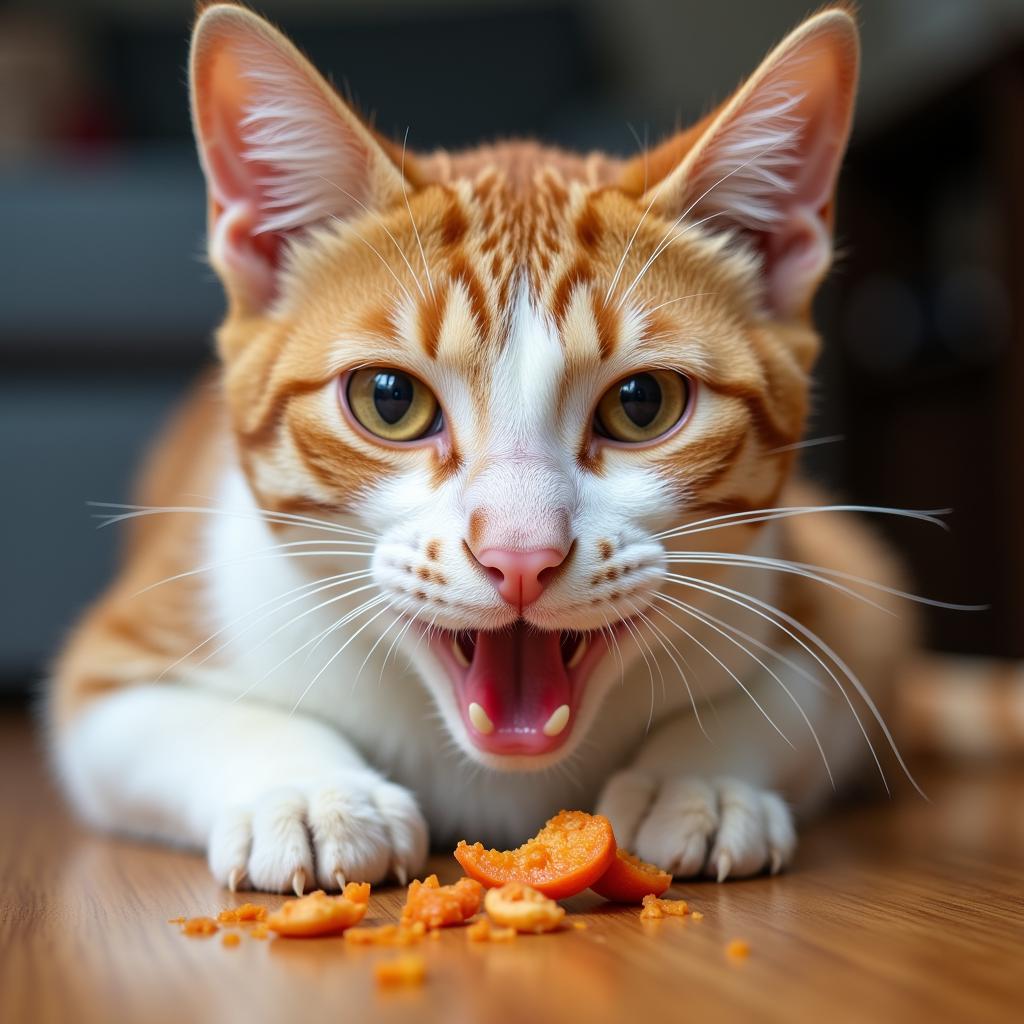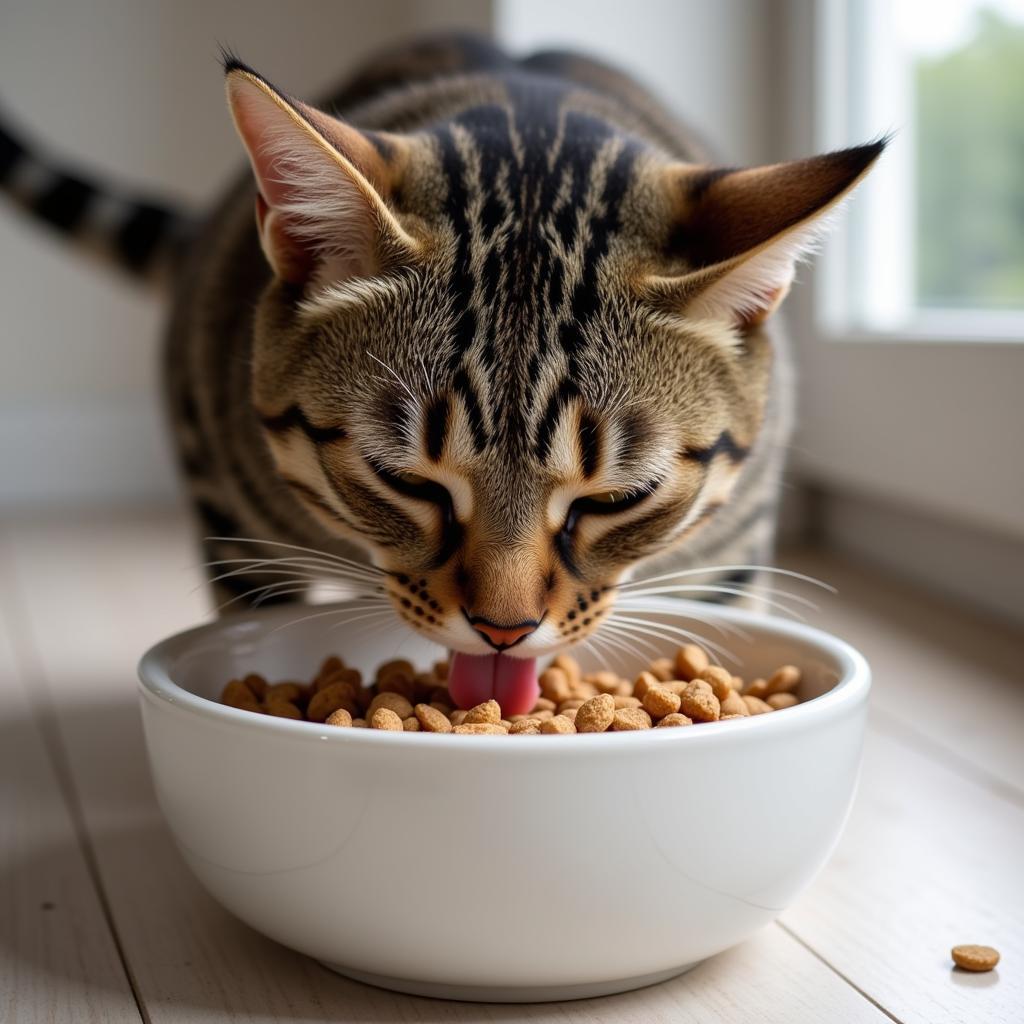Have you ever watched your cat eat and noticed they don’t seem to chew their food? Unlike humans and many other animals, cats have a unique way of eating that often involves swallowing food whole or in large chunks. While this might seem strange, it’s perfectly normal feline behavior rooted in their evolutionary history as hunters.
 Cat Not Chewing Food
Cat Not Chewing Food
The Science Behind Why Cats Don’t Chew
Cats are obligate carnivores, meaning their bodies are designed to thrive on a meat-based diet. Their teeth reflect this evolutionary adaptation. Unlike the flat molars humans use for grinding, cats have sharp, pointed teeth perfect for tearing and ripping flesh. They lack the necessary teeth for grinding plant matter or chewing their food thoroughly.
Furthermore, cats have a relatively short digestive tract compared to herbivores or omnivores. Their stomachs are highly acidic, allowing them to break down large pieces of meat and bones. This biological design further eliminates the need for extensive chewing.
Is It Normal for My Cat to Swallow Food Whole?
While it might seem alarming, swallowing food whole or in large pieces is completely normal for cats. However, several factors can influence how much a cat chews, including:
- Type of food: Cats might chew on larger chunks of dry kibble more than wet food.
- Age: Kittens and senior cats might chew less due to developing or missing teeth.
- Dental issues: Pain or discomfort in the mouth can make chewing difficult.
- Competition: Cats in multi-cat households might gulp down food quickly to avoid sharing.
When to Worry About Your Cat’s Eating Habits
While swallowing food without chewing is generally harmless, there are instances when it can signal a problem. Contact your veterinarian if your cat exhibits any of these behaviors:
- Sudden change in eating habits: A cat that suddenly stops chewing when it used to could indicate a dental issue.
- Excessive drooling: This could indicate pain or difficulty swallowing.
- Choking or gagging while eating: This suggests the cat is having trouble swallowing larger pieces.
- Vomiting undigested food: The cat’s system might not be breaking down food properly.
Tips to Encourage Healthy Eating Habits
- Choose the right food: Offer a balanced diet of high-quality wet and dry food appropriate for your cat’s age and health status.
- Consider food size and shape: Smaller kibble or shredded wet food might be easier for cats to swallow.
- Feed multiple small meals: Encourage slower eating by offering food in smaller portions throughout the day.
- Provide fresh water: Water helps soften food and aids in digestion.
- Schedule regular vet check-ups: Routine dental cleanings and check-ups can help prevent dental issues that make chewing difficult.
 Cat Eating Dry Food
Cat Eating Dry Food
“Cats are natural hunters, and their eating habits reflect this instinct,” says Dr. Jane Miller, a veterinarian specializing in feline health. “While their ability to swallow food whole is fascinating, it’s crucial to monitor your cat for any changes in eating behavior that might indicate a health concern.”
Conclusion
While seeing your cat swallow food without chewing might seem unusual, it’s a natural part of being a feline. Understanding their unique digestive system and observing their eating habits can help you ensure your cat stays happy and healthy. If you notice any concerning changes in your cat’s eating behavior, consult your veterinarian for a proper diagnosis and treatment plan.
FAQs
1. Is it bad if my cat throws up undigested food?
Occasionally vomiting undigested food might not be a cause for concern, but frequent episodes could indicate a digestive issue. Consult your vet.
2. Can I train my cat to chew its food?
You can’t train a cat to chew like humans, but you can encourage slower eating by using puzzle feeders or offering smaller, more frequent meals.
3. Why does my cat eat so fast?
Cats might eat quickly due to competition, anxiety, or previous experiences with food scarcity.
4. Should I be worried if my cat only eats dry food?
While some cats can thrive on a solely dry food diet, it’s essential to ensure they are adequately hydrated.
5. What are some signs of dental problems in cats?
Bad breath, excessive drooling, pawing at the mouth, and difficulty eating can all be signs of dental issues.
For further assistance, please contact our 24/7 customer support team at Phone Number: 02437655121, Email: [email protected], or visit our address: 3PGH+8R9, ĐT70A, Trung Village, Bac Tu Liem District, Hanoi, Vietnam. We’re here to help!